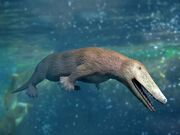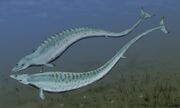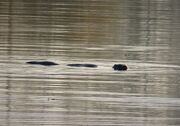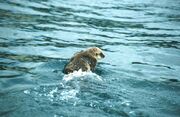No edit summary Tags: Source edit Mobile edit Mobile web edit |
|||
| Line 3: | Line 3: | ||
|Image=[[File:Super otter Coudray.png|thumb|240px|center|Illustration of the super-otter by [[Philippe Coudray]] in ''[[Guide des Animaux Cachés]]'' (2009).]] |
|Image=[[File:Super otter Coudray.png|thumb|240px|center|Illustration of the super-otter by [[Philippe Coudray]] in ''[[Guide des Animaux Cachés]]'' (2009).]] |
||
|System=[[Heuvelmans system]] (1965) |
|System=[[Heuvelmans system]] (1965) |
||
| + | |Names=''Super-loutre'' |
||
|Scientific names=''Hyperhydra egedei'' <small>(Heuvelmans, 1968)</small><br>''Hyperhydra norvegica'' <small>(Thomas, 1996)</small> |
|Scientific names=''Hyperhydra egedei'' <small>(Heuvelmans, 1968)</small><br>''Hyperhydra norvegica'' <small>(Thomas, 1996)</small> |
||
|Location=Norwegian Sea and Barents Sea |
|Location=Norwegian Sea and Barents Sea |
||
Revision as of 12:11, 19 June 2021
| ||||||||||||||
The super-otter (Hyperhydra egedei; French: super-loutre) is a Heuvelmans type of sea serpent, reported from the coasts of Norway until 1848. Based on twenty-eight sightings, of which he considered thirteen certain and fifteen probable, Bernard Heuvelmans described the super-otter as a four-limbed otter-like animal of enormous, but often exaggerated, size. He believed it lived in the icy Arctic waters, moving south into the Norwegian Sea in the Summer.[1]
Although Heuvelmans considered them distinct, later authors have noted close similarities between the super-otter and the many-humped sea serpent of the North Atlantic;[2][3] it has been argued that Heuvelmans distinguished the super-otter purely on geographic grounds. One of the super-otter's principal foundations, Egede's serpent, has also been repeatedly reinterpreted.[4] Heuvelmans identified the type as a descendant of the earliest, amphibious cetaceans, which were then unknown in the fossil record.[1] Although Eocene cetaceans such as Ambulocetus and Kutchicetus have since been discovered, Karl Shuker argues that a more parsimonious explanation is a zeuglodon, thus synonymising the super-otter and the many-humped.[4] Michael Woodley identifies both as related but probably-distinct species of gigantic sea otter,[3] while the Coleman-Huyghe system creates the classic sea serpent out of these types and the super-eel.[2]
Sea serpents classified as possible super-otters
- Malmö (Norway, before 1666)
- Dramsfjord (Norway, 1667)
- Egede's (Greenland, 1734)
- Korsbeck's (Norway, 1744)
- Ferry's (Norway, 1746)
- Sundsland (Norway, before 1753)
- Tuchsen's (Norway, before 1753)
- Sundmör (Norway, before 1753)
- Bergen (Norway, ~1759 and ~1763)
- Ball's (Baltic Sea, ~1781)
- Schilderup's (Norway, 1819)
- Greger's (Norway, 1819)
- North Cape (Norway, before 1820)
- Bishop of Nordland and Finmark's (Norway, before 1820)
- Gravedigger's (Norway, before 1820)
- Hundholm (Norway, 1820)
- Soröy (Norway, 1822)
- Oslofjord (Norway, 1827)
- Lund's (Norway, 1845)
- Stirling's (Norway, 1845)
- Salomonson's (Norway, 1846)
- Romsdalfjord (Norway, before 1848)
Theories
Ambulocetid, remingtonocetid, or protocetid

Ambulocetus, unknown in 1965, is a good match for Heuvelmans' theoretical "primordial Archaeocetus," but resembled a crocodile more than an otter (Source).

Kutchicetus, which has been compared to an otter, is the early cetacean most closely resembling the super-otter (Source).
Considering that the super-otter, which was certainly a mammal, was too large to be a true otter and had too long a tail to be a pinniped, Heuvelmans concluded that it must be a cetacean. Its distinct neck and flexible spine were suggestive of a zeuglodon, but, as discussed below, the super-otter's four limbs and tail shape argued against this identity. Consequently, Heuvelmans suggested that the super-otter was the descendant of a hypothetical earlier stage of whale evolution...[4]
| “ | [...] an animal that had not yet lost its hind legs, which would need no ridges and merely have a long tapering tail. This primordial Archaeocetus would therefore look like a gigantic otter, just like our Super-otter, which would then be the most primitive of all the cetaceans, one of which we have no fossil remains, but which had developed to a giant size in the Arctic.
|
” |
When Heuvelmans made this suggestion, the now well-known families of "walking whales," Ambulocetidae and Remingtonocetidae, were unknown in the fossil record, although some fully-aquatic members of the family Protocetidae were known. Ivan T. Sanderson had speculated on putative "first ancestors" in Follow the Whale (1956), in which he suggested that such animals might still survive, a possible inspiration for Heuvelmans' theory.[4] Ambulocetus natans was not described until 1994, and when it was, it was seen as closely corresponding to Heuvelmans' theoretical "primordial Archaeocetus," with its four limbs, tapering tail, and otter-like mode of locomotion.[4] Ambulocetus and many other amphibious and aquatic early cetaceans lived in the coastal waters, mangroves, brackish estuaries, and freshwater lakes, rivers, and swamps of tropical South Asia throughout the Early and Late Eocene, mainly hunting fishes and small mammals.
Karl Shuker, while conceding that something like Ambulocetus, but much larger, might perfectly explain the super-otter, argues in favour of a more parsimonious identity, that of a zeuglodon, which would synonymise the super-otter with the many-humped sea serpent, turning two undiscovered species into one.[4]
Although Ambulocetus may have swam like an otter, it and most of its relatives would have more closeley resembled mammalian crocodiles than giant otters. According to Michael Woodley, the only early cetacean bearing any resemblance to the super-otter was the remingtonocetid Kutchicetus (~46–43 MYA). Kutchicetus, alongside its close relative Andrewsiphius (~50–40 MYA), lived in tropical South Asia during the Early to Middle Eocene. Sometimes compared to an otter in their skeletal anatomy,[5] remingtonocetids had long narrow snouts, short legs, and strong tails, as well as vertebral proportions similar to those of otters; in terms of locomotion, Kutchicetus itself has been considered a cetacean analogue to the giant river otter (Pteronura brasiliensis).[5] However, it was among the smallest of the early cetaceans, and whether it preferred freshwater or saltwater is debated. In general, remingtonocetids are thought to have inhabited water with low visibility, and have been found in formations suggestive of algal reefs, seagrass meadows, muddy beaches, coastal swamps, and shallow inlets. All remingtonocetids were probably powerful swimmers, but clumsy on land.[5]
Woodley argues that an ambulocetid, remingtonocetid, or protocetid identity for the super-otter is unlikely because most of its characteristic features–such as a "lumpy" body, four distinct limbs, and fur–were phased out of the ocean-going cetacean body plan early in their evolution. Nevertheless, Woodley does cautiously suggest a protocetid identity for certain marine saurians.[3] More recently, larger protocetids also compared to otters have been discovered elsewhere, such as the Peruvian Peregocetus (~42 MYA), indicating that quadrupedal protocetids did attain a wide marine distribution while retaining all four limbs.
Zeuglodon

Karl Shuker argues that a zeuglodon could explain the super-otter, eliminating the need for a distinct type (Source).
Basilosaurus was a large, eel-shaped Eocene cetacean which, alongside its close relatives, is usually called a zeuglodon in cryptozoology. Heuvelmans rejected a zeuglodon identity due to the super-otter's four distinct limbs and lack of a bilobate tail, features which Basilosaurus and its relatives had already evolved past.[1] However, Karl Shuker argues that a zeuglodon would indeed be a plausible identity for the super-otter, thus eliminating it as a type distinct from the many-humped sea serpent. Shuker points out that, in light of modern palaeontological knowledge, the super-otter's four limbs do not necessarily remove the zeuglodon as a candidate. In 1989, complete skeletons of Basilosaurus isis discovered in Egypt revealed that this cetacean did in fact retain small, but functional, hind limbs. Remains of such limbs had been found before, but had been assumed to be purely vestigial. Shuker argues that, if these limbs were external and prominent enough to be noticed by eyewitnesses, they could satisfactorily explain sightings of four-limbed super-otters.[4]
Giant otter

Michael Woodley theorises that the super-otter is a giant, marine relative of the Eurasian otter (Lutra lutra) (Source).

The known sea otter (Enhydra lutris), a Pacific animal, is among the smallest of marine mammals (Source).
Although Heuvelmans wrote that the super-otter might appear at first glance to be an otter or a pinniped–a fact which gives it its name–he argued against an otter identity on account of the super-otter's far greater size, which he admitted was sometimes exaggerated. His conclusion was that "the animal is much too big to be classed among the otters with any probability".[1] The largest known living otter, the freshwater giant river otter (Pteronura brasiliensis) of South America, officially grows to between 5' and 6', but lengths of 12' or even 20' have been reported.[6] The marine sea otter (Enhydra lutris) is also among the largest, growing to almost 5' in length. Fossil species such as Siamogale, Enhydriodon, and Megalenhydris reached greater sizes, and giant freshwater otters also occur in cryptozoology, such as the iemisch and dobhar-chú.[7] Shuker has also considered a giant otter identity, but preferred the zeuglodon theory on account of that animal's known prehistoric existence.[4]
Michael Woodley finds Heuvelmans' rejection of an otter identity surprising, arguing that it is the only acceptable explanation for both the super-otter and the many-finned sea serpent. Apart from the general resemblance observed by Heuvelmans, the most relevant characteristic of otters when considering the super-otter is their highly-flexible bodies and undulating tails, which might create the illusion of humps so often described in the super-otter. In fact, this phenomenon is known in observations of the giant river otter.[3] Heuvelmans also made such a comment on the sinuous shape of an otter, and noted the origin of the otter's name, which is ultimately derived from terms meaning "water snake".[1] In addition, the super-otter has been described as woolly-furred, similar to the sea otter, which, unlike many other marine mammals, is insulated by its fur instead of by blubber.[3]
Due to its geographic range, Woodley suggests that the super-otter would likely be allied to the Eurasian genus Lutra, the common species of which (Lutra lutra) may grow up to 3' long, with a 1'5'' tail. He further suggests that the many-humped sea serpent may be closely-related, but better-adapted for a marine lifestyle, and that the Irish dobhar-chú may be some kind of relative.[3]
Other theories

Early amphibians such as Prorastomus have also been compared to otters (Source).
Heuvelmans discounted a pinniped identity due to the super-otter's long, tapering tail,[1] though Philippe Coudray writes in tacit support of this theory.[8] Heuvelmans briefly considered a sirenian identity for both the super-otter and the many-humped,[1] and some early amphibious sirenians did somewhat resemble bulky otters, but Woodley rejects this theory because no known modern sirenian has a functional pelvis, meaning that, for the super-otter to be a sirenian, it would have to be of a branch unknown in the fossil record, which developed down a unique evolutionary path.[3] More recently, Carl Marshall has argued that both types are a species of baleen whale with a unique feeding method, which he calls the "wrong whale".[9]
Notes and references
- ↑ 1.0 1.1 1.2 1.3 1.4 1.5 1.6 Heuvelmans, Bernard (1968) In the Wake of the Sea-Serpents, Hart-Davis, ISBN 9780246643124
- ↑ 2.0 2.1 Coleman, Loren & Huyghe, Patrick (2003) The Field Guide to Lake Monsters, Sea Serpents and Other Mystery Denizens of the Deep, TarcherPerigree, ISBN 978-1585422524
- ↑ 3.0 3.1 3.2 3.3 3.4 3.5 3.6 Woodley, Michael (2008) In the Wake of Bernard Heuvelmans: An Introduction to the History and Future of Sea Serpent Classification, CFZ Press, ISBN 978-1905723201
- ↑ 4.0 4.1 4.2 4.3 4.4 4.5 4.6 4.7 Shuker, Karl P. N. (2016) Still In Search Of Prehistoric Survivors: The Creatures That Time Forgot?, Coachwhip Publications, ISBN 978-1616463908
- ↑ 5.0 5.1 5.2 Thewissen, J. G. M Hans (2014) The Walking Whales: From Land to Water in Eight Million Years
- ↑ Mackal, Roy P. (1980) Searching for Hidden Animals: An Inquiry Into Zoological Mysteries, Cadogan Books, ISBN 978-0946313051
- ↑ Eberhart, George M. (2002) Mysterious Creatures: A Guide to Cryptozoology, ABC-CLIO, Inc., ISBN 1576072835
- ↑ Coudray, Philippe (2009) Guide des Animaux Cachés, Editions du Mont, ISBN 978-2915652383
- ↑ Marshall, Carl "Leviathan and the 'Wrong Whale'," CFZ Yearbook 2020 (2020)

